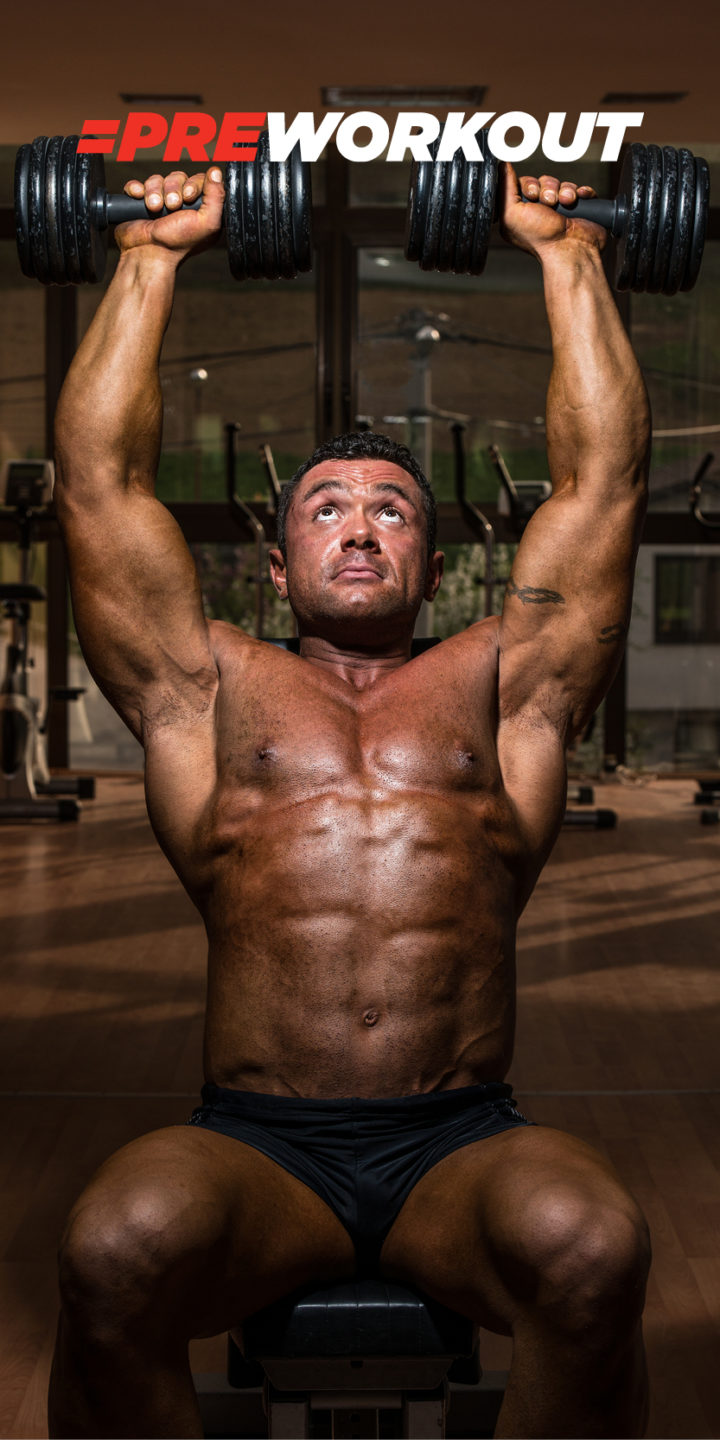(With Three Great Deltoid Workouts)
Shoulders are one of the more complex muscle groups in your body to train. Different “heads” compose the shoulders, all attaching to multiple different areas on your body. That is why there is no one movement to train your shoulders that is going to maximally improve strength and hypertrophy.
Instead, to optimally train your shoulders, or deltoids, you need to implement exercises that take them through different ranges of motion, apply loads at different angles, hit all three “heads” of the deltoid, and support surrounding musculature. In doing all these movements together, not only will you build bigger and stronger shoulders, but more stable and healthy shoulders.
In this article, we are going to help you learn everything you need to know about growing bigger, stronger, and healthier shoulders. This includes:
- Learning how the shoulder joint and all three heads of the shoulder work and what they do.
- Learning what it means to progressively overload the shoulders.
- Covering which exercises are best with dumbbell, barbell, bodyweight, and cable for strength and growth.
- Leaving you three killer shoulder workouts to help get you started and progress more quickly
- Giving you supplements to pair with the training to increase strength, size, and recovery.
- How to get an incredible pump on shoulder day.
- A Frequently Asked Question section covering some of the common questions and misconceptions about training your shoulders.
So let’s get started.
There are three “heads” that make up the deltoid muscle. The anterior, or front deltoid, the lateral, or side deltoid, and the posterior, or rear deltoid. We are going to cover each one in depth so you can understand why each movement you do in the gym correlates with each head of the deltoid.
The Anterior Deltoid:
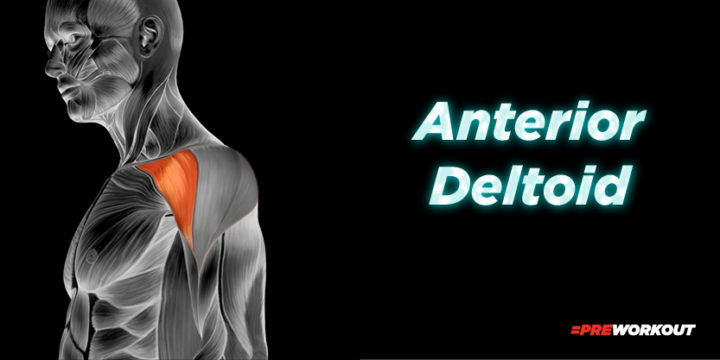
The anterior deltoid sits on the front-facing side of your shoulder. This muscle originates from the third portion of the clavicle and inserts mid-way down the lateral aspect of the humerus. In layman’s terms, the muscle starts in your collarbone and attaches about midway down the side of your upper arm.
Of all the muscle groups of the body, the anterior deltoid is most likely the one you train the most, usually making the front deltoid more pronounced than the rest of your shoulder. Unfortunately, this is likely the main reason why your shoulder as a whole looks underdeveloped.
The anterior deltoid “works as a synergist to the pectoralis major for horizontal adduction and is the primary mover in shoulder flexion as well as when the humerus is externally rotated” (Rogers, 2019). This means during any bench pressing (horizontal adduction) movement and even with some chest-fly movements, you will work your anterior deltoid to an extent. And when you have a shoulder day that implements a pressing movement where your arm is overhead (external humerus rotation), the anterior deltoid is the primary mover. Some people will implement front shoulder raises to bias the anterior deltoid even more (shoulder flexion).
So now that you know how involved this part of your deltoid is with shoulder and chest movements, how necessary do you think anterior deltoid isolation is? You guessed it! Very minimal, if any, extra isolation is necessary.
The Lateral Deltoid:
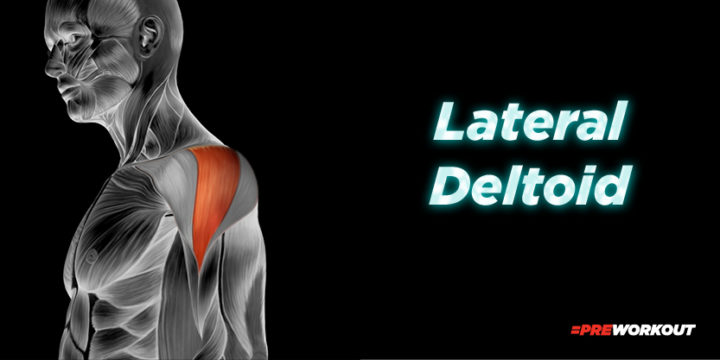
The lateral deltoid sits on the side of your shoulder. When you think about giving your shoulders more “width”, this is the muscle that is going to make that happen.
A fun little side note; the larger your side deltoids, the slimmer your waistline will look! This muscle originates from “the lateral and superior surface of the acromion. It also inserts into deltoid tuberosity slightly posterior to the anterior deltoid” (Rogers, 2019). Again in layman’s terms, this muscle starts on the top of your shoulder and inserts right behind your anterior deltoid mid-way down your upper arm.
The function of this muscle is shoulder abduction. Simply put, this means raising your arms away from your side. As stated before, this is the muscle that is going to give your shoulders that wide, broad, or toned look. If you are going for aesthetics, then this is the muscle to primarily focus on when training shoulders.
The Posterior Deltoid:
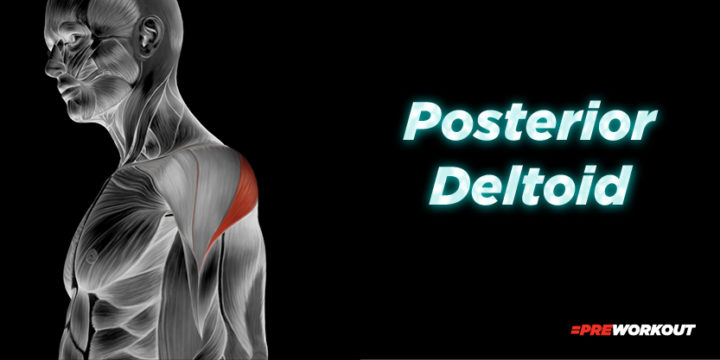
Finally, we have the posterior, or rear deltoid. This muscle originates just above the scapula and inserts just behind the lateral deltoid in the upper arm. The rear deltoids sit on the back side of your shoulder and perform the opposite function of the anterior deltoid. These serve to extend and externally rotate the shoulder joint as well as horizontal extension.
According to many experts: “Of the three deltoids, the posterior deltoid is most likely to be under-developed. A lot of exercisers don’t train this muscle because they can’t see it in the mirror” (Dale, 2021). Another big reason is, unlike the anterior deltoid, these are not as strong of a synergist in back movements as the anterior deltoids are in chest movements.
In my own experience, a lot of people who have under-developed rear deltoids also suffer from posture imbalances, such as having internally rotated shoulders. So not only will training this muscle give you more aesthetic and healthier shoulders but also help with bringing up your bench press!
How to Progressively Overload the Deltoids:
When talking about training any muscle for strength and hypertrophy, the most optimal strategy is going to be progressive overload. What is progressive overload though?
The National Academy of Sports Medicine, or NASM, states that “3 mechanisms of building muscle through strength and hypertrophy are metabolic damage, muscle-tension (force), and exercise-induced muscle damage. With respect to progressive overloading, you are effectively attacking the muscle-tension variable by increasing the load and causing an adaptation in force output of the muscle over time.”
Simply put, this means to keep progressing in strength and hypertrophy, you will need to make some small change to the workout every time. There are many ways to do this: increasing the intensity, changing the timing of the exercise (time under tension), introducing new movements, adding advanced training techniques such as drop-sets or cluster sets, or by increasing the amount of repetitions.
To further clarify this, I will provide some examples of progressive overload pertaining to the shoulders:
1. Say you start shoulder press at reps with 50lb dumbbells. You work up to where you can do 12 reps. Once you can easily hit all sets for 12 reps, it is time to up the weight and repeat the cycle.
2. If you are doing your reps fast, another way to overload would be to slow the reps down to increase time under tension. Shoot for 45 seconds-1 minute per set.
3. Another way to increase intensity would be to add advanced techniques that push you beyond failure. Do not do these on compound movements. Start by doing a drop set, which means once you reach failure, drop the weight 20% and go to failure again.
It is time to get into the actual exercises that are going to make the biggest difference in the strength and hypertrophy of your deltoids.
I am going to cover which ones are best with dumbbells, body weight, barbell, and machines/cables, as well as which ones are best for hitting each one of the deltoids. I am also going to give a few tips with each exercise concerning proper form so you get the most out of it.
The Best Shoulder Exercises with Dumbbells
1. Seated or Standing shoulder press for the anterior deltoid. These are usually best when done in the 6-12 rep range to put the most amount of force and tension on the muscle. To get the most out of this movement, try your best not to arch your back while pressing. If you are arching your back, then you need to lower the weight as this puts unneeded stress on your back and neck. The same goes for standing. You can press both arms at a time or to add more emphasis on your core, press each arm separately. To more optimally align with the anterior deltoid, turn your hands in a little bit at the bottom of the pressing motion.
2. Seated or standing lateral raises for the lateral deltoid. These are best done in the 8-15 rep range. Starting with your hands at your side and raising out to side till they are parallel to the floor. Act like you are lifting with your elbows. This will take your traps out of the movement the best you can. DO NOT swing. Start from a still position and control the weight throughout the entire movement. There are some individuals who swing the weight so they can use heavier weight than normal. However, this can be hard on your shoulder and increases your chance for injury. If you have had any previous shoulder injuries I would use caution when attempting a swing.
3. Bent over raises for the rear deltoid. You can do these in the 8-15 rep range as well. Easily set this up by sitting on the end of the bench and leaning over until your stomach is touching or almost touching your thighs. Again, don’t swing, but control the weight up and down and act like you’re doing a lateral raise but bent over. You should feel a nice burn on the rear side of your shoulder.
The Best Bodyweight Exercises for Your Deltoids
1. Pike pushups or Handstand pushups for the anterior deltoid. This best imitates the motion you do when shoulder pressing with a bar or dumbbells. To perform the pike press, get in a pushup position and walk your feet toward your hands to make an upside-down “v” shape. You can also elevate your knees on a bench if that is more comfortable. Then pretend you’re doing a pushup. If you are more advanced, then give handstand pushups a go! You can do these up against a wall or if you are really advanced, free-standing.
2. Finding a bodyweight exercise to hit the lateral deltoid can be challenging. For this, I will look to physical therapist Jeff Cavaliere. There is no formal name for it, so I will describe how to perform the movement. Start in a plank position, with your forearms on the ground. Pick one arm up and hug your chest with it. Next, using the arm still on the ground, roll your body upwards to the side with the arm not on the ground. It will look kind of like a side plank, but don’t move your forearm position on the ground. Then, control back down to the original starting position (you can even go further than starting position to get a stretch on the lateral deltoid) without putting your other arm down.
3. The Iron Cross. Rear deltoid bodyweight exercises can also be challenging, which is why I will again turn to Jeff Cavaliere. He has named this the “Iron Cross.” Lie flat on your back with your arms straight out to the side, slightly under shoulder level. You can make a fist or put your palms on the ground. Then, simply push through your hands to raise yourself up, and lower yourself back down. You should feel a nice burn in your rear deltoids and some in your traps as well.
The Best Barbell Shoulder Exercises:
Below I’ve listed the three best barbell movements for hitting your deltoids.
1. Seated or Standing Overhead Press
This exercise hits the anterior deltoid. The same applies here as it does for dumbbells. This is an exercise where you can place the most load on the muscle, resulting in the most strength and hypertrophy progress.
2. Upright Row
To hit the lateral deltoids, one of the better barbell exercises is going to be the upright row. This can seem controversial to some, but with strict form and ego lifting (lifting too much weight) out of the way, these can be a beneficial move for the lateral deltoid. To bias more of the lateral deltoid, you want to take a wider grip, at or just outside of shoulder width. When you raise your arms, DO NOT bring your arms up past your shoulders. This is where shoulder impingement can occur. I like the higher rep lighter weight, but some people prefer the 6-10 rep range. If you do go on the heavier side, you need to make sure your form is good.
3. Meadow’s Row
One of my favorite barbell exercises for the rear deltoid I got from IFBB Pro John Meadows. It’s simply called “Meadow’s row.” You place one end of the barbell in the free-standing landmine holder or simply slide it into a corner of a wall. Place a weight on the other side of the barbell. Stand in a split stance with your left foot about a foot in front of the right and bend over like you’d be doing a row. Grab the weighted end of the barbell with your right hand in an overhand grip. Keep your elbow out and row the bar upwards with a squeeze at the top and you should feel a nice burn in your rear deltoid. Repeat for the other side.
Cable and Machine Exercises for Shoulders
1. Machine or Cable Shoulder Press
Machine shoulder press or cable shoulder press for the anterior deltoid. Using cables or machines will keep more tension on the muscle throughout the full range of motion. You can do these anywhere in the 6-12 rep range for strength and hypertrophy. If you have a machine that has different handles for shoulder press, try to opt for ones that keep your hands in a neutral position, as this more aligns with the fibers of the front deltoid.
2. Single-Arm Cable Lateral Raise
This exercise targets the lateral deltoid. These are awesome to keep tension on the lateral deltoid, whereas with dumbbells there will not be constant tension throughout the whole range of motion. Pick a light weight, try to squeeze at the top for a second, and on the way down, let your arm go across your body to get more of a stretch on the muscle. I like doing these for higher reps and also incorporate drop sets at the end.
3. Standing reverse cable fly
This exercise targets the rear deltoids. You can do these single arm or both arms at a time, whichever is your preference. While standing, set the cables up at eye level or a little higher. Then, with your right arm grab the left cable, and with your left arm grab the right. Pretend like you are doing a chest fly but backward. You should feel a nice burn in the rear deltoids.
Supplements For Maximizing Gains:
Next, let’s talk about supplements you can use alongside an awesome workout program and proper nutrition. We also suggest you read the best pre-workout ingredients for strength and power.
Remember, supplements are not going to do all the work. Without a proper exercise and nutrition program, supplements will hardly do anything. It’s better to focus on proper nutrition and exercise, rather than adding in supplements to try and fix any issues. With that caveat out of the way, let’s get into some awesome supplements that not only can help you recover quicker, but improve strength and size quicker as well.
1. Creatine
In case you haven’t heard what creatine is by now, I’ll give you a rundown. Mayo Clinic says “Creatine stores in your muscles as phosphocreatine.” Naturally those phosphocreatine stores are not full (unless you are eating 20 pounds of red meat a day).
When you take creatine and fill up those stores, your body is able to start with more energy (ATP) in your muscles AND recycle that ATP quicker! This means you will have more power and recover quicker among other benefits. There are no negative liver or kidney side effects that are commonly associated with creatine. The only concern is if you have pre-existing conditions.
With creatine, it does not matter what time of day you take it, just that you take it every day.
There are two primary forms of creatine I would look for:
- Creatine Monohydrate. If you have not taken it before, there is a “loading phase” associated with it. You want to take 20 grams per day for the first week, and then after is just 5 grams a day.
- Creatine Hydrochloride: with monohydrate, some people can experience bloating and stomach upset, as well as weight gain from water. Although the water is inside of your muscle, seeing the scale move can bother some people. Hydrochloride has the same benefits as monohydrate, but its easier on your stomach, holds less water, and you don’t need to drink as much water (even though you should still be hydrating well). I would shoot for 1.5 grams a day. There is no need to do a “loading phase” with this version.
Benefits of creatine: improved power, improved time to exhaustion, improved strength, increase rate of muscle gain, boost recovery, and recently has been shown to have brain and heart benefits. There are NO side effects to your liver or kidneys unless you have pre-existing conditions.
2. Protein
If you have no issues with dairy, it’s best to use a whey concentrate or isolate. If you do have issues with dairy, consider trying an animal or vegan-based protein. Whey and animal-based do get utilized in your body better than vegan protein, so keep that in mind while choosing. Try to get one with the least amount of added sugar. I want you to try and get protein through food, as there are more micronutrients in food than protein powder, but if you are struggling to get in enough protein, then a powder can be an easy, convenient way to get enough.
I would like to take some time to address a big misconception about protein. The misconception is you need to slam a protein shake right after you leave the gym. This is not necessary by any means. There technically is an “anabolic window” but it is not in the first hour after you leave the gym like I’m sure you have heard. As long as you have had a meal within a few hours of going to the gym, just make sure you get in another meal within an hour or two of leaving the gym.
3. Essential Amino Acids, EAA
These will dramatically improve your recovery and can also speed up muscle growth. Sip on them during the workout. If drinking something during the workout gives your stomach issues then drink them right after. I would highly recommend these over BCAA’s (Branch Chain Amino Acids). BCAA’s can only start the protein synthesis process, while EAA’s can actually help you synthesize new proteins. John Meadows has an awesome analogy for this, “BCAA’s are like starting a car with no gas to go anywhere, EAA’s are like putting gas in to actually get you places.”
4. Omega 3 Fatty Acids
The Institute for Natural Medicine states that “as many as 95% of Americans lack EPA and DHA in their diet.” These key nutrients plays a role not only in the cardiovascular system, but can help with brain and eye health, lower markers of inflammation across the body which leads to better recovery, better hormone health, and even better joint health. Unless you are eating a couple servings of cold-water fatty fish a week or anchovies and sardines and lots of walnuts, then you may benefit from this supplement.
The recommended intake for women is around 1.2 grams per day, while men are around 1.6 grams per day in total omega 3’s. Another important aspect to look at is the EPA and DHA components of the fish oils. You want to make sure to get between 250-500 milligrams per day.
So far we have talked about how each of the heads of the deltoid work, how to progressively overload the deltoids, what the best exercises are for different types of equipment, and which supplements could boost muscle growth, strength and recovery. Now, let’s talk about five things you can do to get a ridiculous pump on shoulder day:
1. Utilizing carbohydrates in your diet. If you are on a lower carbohydrate diet, then your muscle glycogen stores are not at their full capacity. This means your muscles will literally look not as full, or big. Aim to add 30-40 grams of carbs into your pre-workout meal.
2. Sleep. This is probably the most important item on this list. Not getting enough sleep means your body’s metabolism, nervous system, brain function, muscle function, and more will not be at full capacity the next day. This means your workout and recovery will suffer. You should be aiming for a good 7-9 hours of sleep.
3. Hydrate. Water makes up most of your body and muscles. If you are not fully hydrated, not only will your muscles not work to the full extent, but your muscle pump will suffer as well.
4. In addition to hydration, add some extra sodium, or salt, to your pre-workout meal or supplement. This will boost muscle pumps tremendously. Sodium enhances your body’s ability to move water into muscle cells while working out. This electrolyte can also help with strength because of its hydrating abilities. Shoot for about 1/4 teaspoon with the meal or pre-workout.
5. Advanced training techniques. Utilizing supersets or drop-sets or any type of training that involves flooding the muscle with the most amount of blood and water will help to achieve the best pump. A higher load with fewer reps is usually not the best when it comes to pumps.
To end this article, I want to leave you with three killer workouts you can try for your shoulders the next time you hit a shoulder day:
Frequently Asked Questions About Shoulder Exercises
- What’s the best shoulder exercise for increasing shoulder mass?
The overhead press would be the best exercise for shoulder mass, as this exercise can place the maximum load and tension on the deltoid. - What’s the best shoulder exercise for increasing width?
Any variation of the lateral raise is going to give your shoulders the most width. - Which shoulder exercises can I do at home?
This depends on what equipment is at home. If you do not have any equipment, referring back to the bodyweight exercises would be beneficial. - Are there shoulder exercises I can do with no equipment?
Yes, there are many you can do at home. I would recommend starting with Pike Press variations to put the most load on the muscle. Once you are more advanced, working on wall-handstand pushups would be the progression. - Can I gain shoulder strength without bulking up and gaining mass?
You would simply focus on the higher load, less repetition way of exercising. In the 1-5 rep range is where you will see the most strength gains. - What are the best shoulder exercises for women and what are the best for men?
Both men and women can perform the same exercises to increase strength and size in the shoulders. Women are not naturally going to “bulk up” the way men will, just become more toned. There is no difference in the way men’s or women’s shoulders work, so doing the same exercises will be optimal.
Author Bio
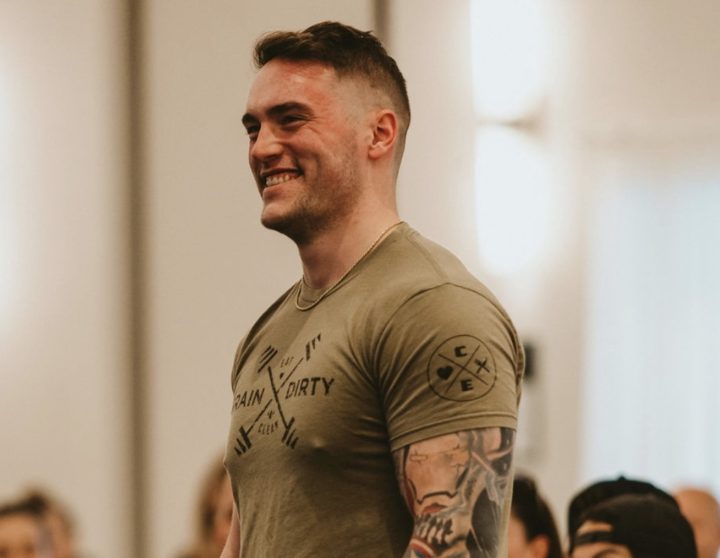
Sam Lipscomb has been an avid health and fitness enthusiast for over 6 years now. He is a Certified Personal Trainer and Nutritionist who has spent years learning about health, nutrition, fitness, the human body, and supplements in order to better help the individuals he interacts with.
His goal has been to learn everything he can to help others achieve their fitness goals and get accurate fitness information.
References
- Rogers, M. (2022, August 24). Dynamic Deltoids: Understanding and Training the Shoulders Muscles. National Federation of Professional Trainers. https://www.nfpt.com/blog/dynamic-deltoids
- Adams, A. (n.d.). Progressive Overload Explained: Grow Muscle & Strength Today. https://blog.nasm.org/progressive-overload-explained
- Institute for Natural Medicine. (2020, January 22). Are You Getting Enough Omega-3s? » Institute for Natural Medicine. Institute for Natural Medicine » Your Trusted Guide to Natural Health. https://naturemed.org/are-you-getting-enough-omega-3s/
- Dale, P. (2021, September 8). A Head by Head Guide to Deltoid Training. Fitness Volt. https://fitnessvolt.com/deltoid-training/
- Meadows, J. (2017, September 15). BCAAs vs EAAs Supplements What’s the difference & which one is better. Team Mountain Dog. https://mountaindogdiet.com/basic/basic-topic/bcaas-vs-eaas-supplements-whats-the-difference-which-one-is-better/
- Creatine. (2021, February 9). Mayo Clinic. https://www.mayoclinic.org/drugs-supplements-creatine/art-20347591
